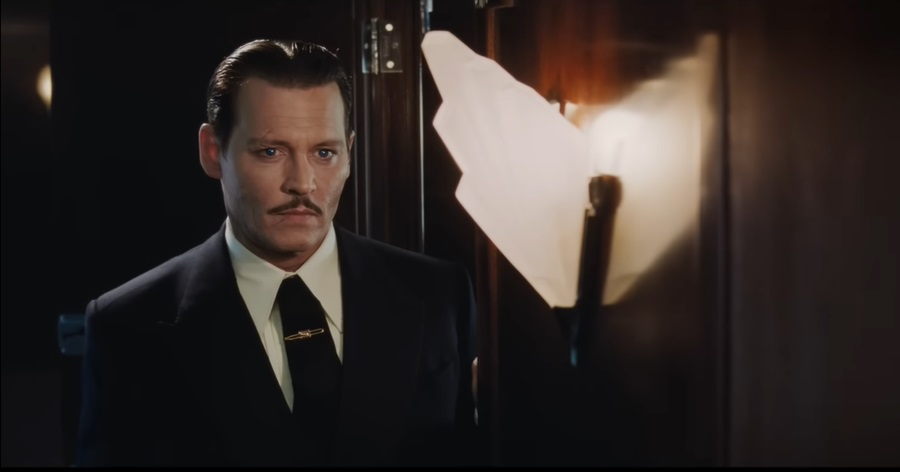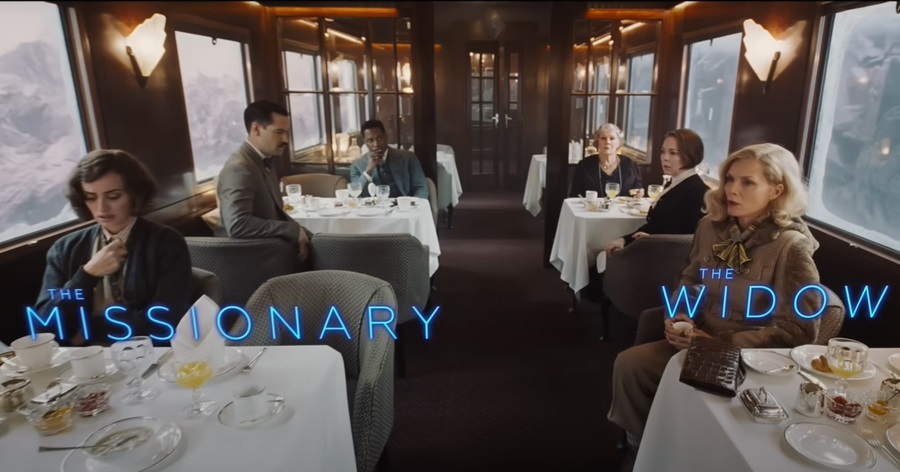Directed by Kenneth Branagh, Murder on the Orient Express is a gripping adaptation of Agatha Christie’s timeless detective novel. The film breathes new life into the classic mystery, featuring an ensemble cast led by Branagh himself, who steps into the iconic shoes of detective Hercule Poirot. Set against the luxurious backdrop of the famous train, the Orient Express, the story unravels a complex murder mystery that keeps viewers on edge till the final revelation. With its intriguing plot, star-studded cast, and a sharp, methodical lead detective, the film weaves a narrative filled with suspense and moral ambiguity.
The film kicks off with Hercule Poirot (Kenneth Branagh), the world's greatest detective, enjoying a vacation after solving a major case in Jerusalem. His plans for a peaceful break are cut short when he is summoned to London for an urgent case. As fate would have it, Poirot secures a berth on the luxurious Orient Express, travelling from Istanbul to Calais. The train is packed with a diverse set of characters, each with their own secrets, making it a perfect setting for a mystery.

Among the passengers is Samuel Ratchett (Johnny Depp), a shady American businessman who expresses fear for his life, offering Poirot a job as his bodyguard. Poirot refuses, sensing something amiss about Ratchett. The next morning, Ratchett is found brutally murdered in his compartment, stabbed 12 times, with no clear indication of who the killer might be. Stranded due to an avalanche that halts the train, Poirot is asked by Bouc (Tom Bateman), the director of the train, to solve the mystery before they reach their destination.

The passengers, including Princess Dragomiroff (Judi Dench), Mary Debenham (Daisy Ridley), Hector MacQueen (Josh Gad), Dr. Arbuthnot (Leslie Odom Jr.), and Caroline Hubbard (Michelle Pfeiffer), become the prime suspects. Poirot interviews each of them, uncovering a tangled web of lies and connections to a notorious past crime: the kidnapping and murder of a little girl named Daisy Armstrong.
As Poirot delves deeper, he discovers that Ratchett was actually John Cassetti, the mastermind behind Daisy’s kidnapping. Cassetti escaped justice after being acquitted, leading to a tragic series of events that devastated the Armstrong family. Poirot must use his unparalleled skills of deduction to untangle the truth and uncover the identity of the murderer.
The Ending of Murder on the Orient Express Explained
The ending of Murder on the Orient Express presents one of the most unique and morally complex conclusions in the detective genre. After careful investigation, Poirot uncovers that each of the passengers on the train had a connection to the Armstrong family and, more shockingly, they all had a hand in Ratchett’s murder. Rather than one killer, the murder was a collective act of justice, driven by the passengers’ shared desire to avenge Daisy Armstrong’s death.
Each passenger had a personal connection to the Armstrong case: Princess Dragomiroff was Daisy’s godmother, Mary Debenham was Daisy’s governess, and Dr. Arbuthnot had served with Daisy’s father in the military. Ratchett’s escape from legal punishment left the passengers haunted by the lack of justice, and they took matters into their own hands, forming a pact to kill him.
In a particularly poignant scene, Poirot is presented with two solutions: the "simple" solution that an unknown assailant broke into the train and killed Ratchett, or the real, more complex solution—that all the passengers participated in the murder. Poirot, a man bound by a strict moral code, is deeply conflicted. Should he reveal the truth and see all the passengers punished for their crime, or should he let them go, understanding that their actions were driven by a desire for justice and closure?
Ultimately, Poirot decides to let the passengers go free, framing the murder as an external crime committed by a mysterious outsider. The decision reflects the ambiguity of justice—while the passengers committed murder, their motivations stemmed from an injustice that the legal system had failed to address. Poirot’s choice to overlook the truth speaks to his growing understanding of the gray areas of morality, a significant departure from his usual black-and-white view of right and wrong.
Why Did the Ending Turn Out This Way?
The ending of Murder on the Orient Express is a reflection of Agatha Christie’s exploration of morality and justice. Unlike conventional detective stories where the goal is to catch a single culprit and ensure they face punishment, this story delves into the idea of collective responsibility and the emotional toll of injustice. The passengers, each grieving in their own way over the death of Daisy Armstrong, see Ratchett’s murder as the only way to right the wrongs that the legal system failed to address.
For Poirot, a man renowned for his rigid adherence to the law, the case forces him to confront the limitations of the legal system. Throughout the film, Poirot is portrayed as a detective with an almost obsessive need for order and justice. However, in this case, justice does not fit neatly into his structured worldview. The passengers are not motivated by greed or malice, but by a sense of duty to avenge an innocent child’s death.
The film’s conclusion is meant to challenge both Poirot and the audience. It raises questions about the nature of justice: Is it always right to uphold the law, even when the law fails to deliver true justice? Can murder ever be justified? The moral ambiguity of the ending is what makes it so powerful, as it pushes viewers to think beyond the typical tropes of the genre and consider the complexities of human emotions and motivations.
Why Didn’t the Woman (Caroline Hubbard) Help Daisy Armstrong?
One of the key elements of the story is the involvement of Caroline Hubbard (Michelle Pfeiffer), who is revealed to be Daisy Armstrong’s grandmother. Her pain and grief over her granddaughter’s death are palpable throughout the film, and it becomes clear that her role in orchestrating the murder of Ratchett was deeply personal. Hubbard, like the other passengers, is haunted by her inability to prevent the tragedy, and her participation in the murder is a way for her to find closure.
Hubbard’s arc is particularly poignant because it shows the toll that grief and guilt can take on a person. Her failure to save Daisy from her tragic fate fuels her desire for revenge, and she becomes the driving force behind the conspiracy to kill Ratchett. In her eyes, by orchestrating Ratchett’s death, she is finally able to deliver the justice that was denied to her family.
Viewers' Reaction to the Ending
The ending of Murder on the Orient Express has sparked mixed reactions among viewers; much like the original novel did when it was first published. Some viewers praised the film for its bold and unconventional conclusion, appreciating the moral complexity and the way it challenges the typical structure of a whodunit mystery. They found the idea of collective guilt and shared responsibility to be a refreshing departure from the usual formula of one murderer and one clear motive.
On the other hand, some viewers were left unsatisfied by the ending, feeling that it lacked the sense of closure that comes with identifying a single culprit. For those who prefer a more traditional detective story, where the hero catches the villain and justice is served, the resolution of Murder on the Orient Express can feel frustratingly open-ended. However, this sense of ambiguity is precisely what makes the story so thought-provoking.
Kenneth Branagh’s portrayal of Hercule Poirot, with his internal struggle over the moral dilemma presented by the case, added depth to the film’s conclusion. Viewers found themselves grappling with the same questions as Poirot—was it right to let the passengers go free, or should they have faced punishment for their actions? The ending leaves room for interpretation, making it a topic of discussion long after the credits roll.
Murder on the Orient Express Conclusion: Justice, Morality, and the Gray Areas in Between
Murder on the Orient Express is more than just a murder mystery; it’s an exploration of justice, morality, and the lengths people will go to right a wrong. The ensemble cast delivers powerful performances that bring Agatha Christie’s characters to life, and Kenneth Branagh’s direction ensures that the story retains its classic charm while adding a fresh, cinematic flair.
The film’s ending, with its morally ambiguous resolution, challenges both Hercule Poirot and the audience to reconsider what it means to deliver justice. In the case of Samuel Ratchett’s murder, the passengers took the law into their own hands, driven by grief and a desire for revenge. While their actions were undeniably illegal, their motivations stemmed from a place of deep emotional pain and a need to rectify a wrong that the legal system had failed to address.
In the end, Poirot’s decision to let the passengers go reflects his growing understanding that justice is not always black and white. Sometimes, the right course of action is not the one dictated by the law, but the one that acknowledges the complexity of human emotions and the gray areas in which morality resides.






